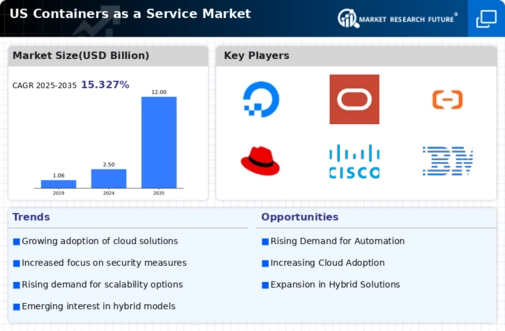The containers as-a-service market is currently characterized by intense competition and rapid innovation, driven by the increasing demand for scalable and efficient cloud solutions. Major players such as Amazon Web Services (US), Microsoft (US), and Google (US) are at the forefront, each adopting distinct strategies to enhance their market positioning. Amazon Web Services (US) continues to leverage its extensive infrastructure and customer base, focusing on innovation in container orchestration and management tools. Meanwhile, Microsoft (US) emphasizes integration with its existing software ecosystem, particularly through Azure, which enhances its appeal to enterprise clients. Google (US), with its Kubernetes expertise, positions itself as a leader in container orchestration, appealing to developers seeking robust solutions. Collectively, these strategies contribute to a competitive environment that is both dynamic and multifaceted.
Key business tactics within this market include localized service offerings and supply chain optimization, which are essential for meeting diverse customer needs. The competitive structure appears moderately fragmented, with a mix of established giants and emerging players. This fragmentation allows for a variety of service offerings, catering to different segments of the market. The influence of key players is substantial, as they set benchmarks for service quality and innovation, thereby shaping customer expectations and industry standards.
In October 2025, Amazon Web Services (US) announced the launch of its new container security service, aimed at enhancing the security posture of containerized applications. This strategic move underscores AWS's commitment to addressing growing security concerns among enterprises, particularly as cyber threats evolve. By integrating advanced security features into its container offerings, AWS not only strengthens its competitive edge but also reassures customers about the safety of their data and applications in the cloud.
In September 2025, Microsoft (US) unveiled a significant update to its Azure Kubernetes Service, introducing enhanced automation features that streamline deployment processes. This update is strategically important as it aligns with the increasing demand for efficiency in cloud operations. By simplifying the management of Kubernetes clusters, Microsoft positions Azure as a more attractive option for businesses looking to optimize their cloud infrastructure, thereby potentially increasing its market share in the containers as-a-service segment.
In August 2025, Google (US) expanded its partnership with a leading cybersecurity firm to bolster its container security offerings. This collaboration is indicative of a broader trend where companies are recognizing the importance of security in cloud services. By enhancing its security capabilities, Google not only addresses customer concerns but also differentiates itself in a crowded market, potentially attracting clients who prioritize security in their cloud strategies.
As of November 2025, current trends in the containers as-a-service market include a strong focus on digitalization, sustainability, and the integration of artificial intelligence (AI) into service offerings. Strategic alliances are increasingly shaping the competitive landscape, as companies seek to combine strengths to deliver comprehensive solutions. Looking ahead, competitive differentiation is likely to evolve from traditional price-based competition to a focus on innovation, technological advancements, and supply chain reliability. This shift suggests that companies will need to invest in R&D and partnerships to maintain their competitive edge in an ever-evolving market.

















Leave a Comment